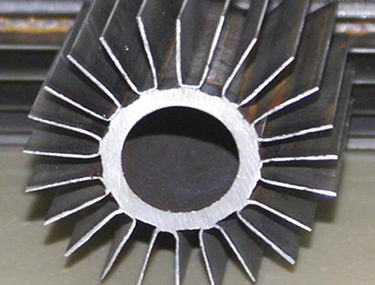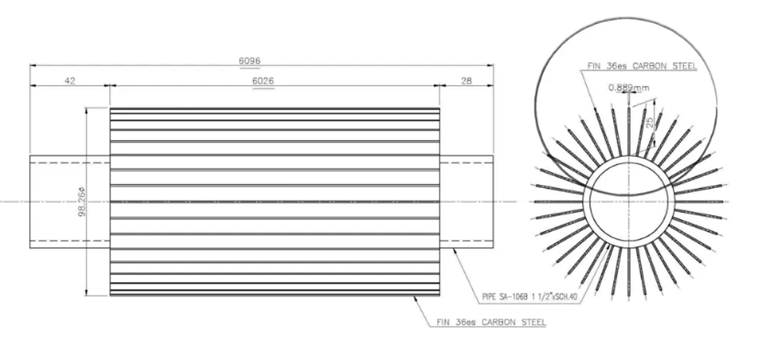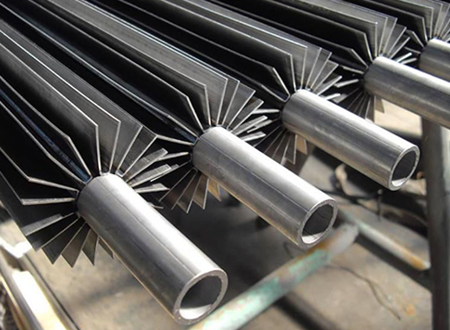Longitudinal Finned Tube For Heat Exchangers
Longitudinal Finned Tube For Heat Exchangers
Longitudinal I/L or U-finned tubes are produced from resistance welded fins along the length of the tube. The fins first form a U-shaped channel so that each leg of the U forms a fin. Channels are cut to the appropriate length, then oriented and resistance welded in place along the length of the tube. The channels are welded in pairs, diametrically opposed, so the number of fins specified must be a multiple of 4.
For a given tube or tube size, the desired heat transfer surface area per unit length of tube can be obtained by specifying the appropriate fin height and number of fins. The number of large fins depends on the outer diameter of the tube - larger OD tubes can accommodate more fins.
Longitudinal Finned Tube For Heat Exchangers Quick Details:
Core tube material: carbon steel, low alloy steel, stainless steel, brass, copper, copper-nickel alloy, aluminum bronze, nickel alloy.
1. Carbon steel: A179, A192, SA210 Gr A1/C, A106 Gr B
2. Stainless steel: TP304/304L, TP316/TP316L
3. Copper: UNS12200/UNS14200/UNS70600, CuNi70/30, CuNi 90/10
4. Titanium: B338 Gr 2
Fin material: aluminum, copper, steel
1. Aluminum (Alu.1100, Alu.1060)
2. Copper.
3. Steel
Fin type: U-fin, perforated, twisted...
Tube Outer Diameter: Min. 19mm.
Tube length: up to 18 meters.
Number of fins: 2/4/8/16/18/32/36 pieces per row
Number of fins: 16/20/24/32/40
Surface Protection: Both bare ends shall be zinc or aluminum metallized by electrospray arc system coating.
Accessories: Tube support boxes, clamps or spacer boxes (materials: aluminium, zinc and stainless steel).
Additional Info
Payment Terms:T/T, LC
Delivery: 15-30 days after payment
Marking: Standard + Steel Grade + Size + Heat No + Lot No
Package: Iron frame packing boxes and the desiccants are put into each package for continental transportation as well. or as required
The case of Longitudinal Finned Tube For Heat Exchangers


We can customize Longitudinal Finned Tube for heat exchanger according to your drawings
Example:

Manufacturing Process:
Longitudinal I/L or U-shaped fins are welded to the core light pipe by resistance welding or filler metal welding (spot welding).
Longitudinal Finned Tube with two different materials
Core tube material: carbon steel, low alloy steel, stainless steel, brass, copper, copper-nickel alloy, aluminum bronze, nickel alloy.
| Carbon Steel Tubes | A179, A192, SA210 Gr A1/C, A106 Gr B, A333 Gr3 Gr6 Gr8, A334 Gr3 Gr6 Gr8, 09CrCuSb, DIN 17175 St35.8 St45.8, EN 10216 P195 P235 P265, GB/T3087 Gr10 Gr20, GB/T5310 20G 20MnG, |
| Alloy Steel Tubes | A209 T1 T1a,A213 T2 T5 T9 T11 T12 T22 T91,A335 P2 P5 P9 P11 P12 P22 P91,EN 10216-2 13CrMo4-5 10CrMo9-10 15NiCuMoNb5-6-4 |
| Stainless Steel Tubes | TP304/304L, TP316/TP316L TP310/310S TP347/TP347H |
| Copper Tubes | UNS12200/UNS14200/UNS70600, CuNi70/30, CuNi 90/10 |
| Titanium Tubes | B338 Gr 2 |
Fin material: aluminum, copper, steel
1. Aluminum (Alu.1100, Alu.1060)
2. Copper.
3. Steel
Quality Control
Inspection and Tests Performed
Chemical Composition inspection,
Mechanical Properties Test(Tensile Strength, Yield Strength, Elongation, Flaring, Flattening, Hardness, Impact Test), S
surface and Dimension Test,
No-destructive Test,
Hydrostatic Test.
Delivery conditions
The tube ends are square cut without burrs, the inside is dry and blown clean, and the ends of the L-shaped tension wound finned tube are coated with varnish on the outside.
Features of Longitudinal Finned Tube
①Increase heat transfer efficiency in effective space.
② Reduce the installation space of the required heat transfer surface
③ Reduce equipment cost and have high operational reliability.
④ Reduce the pressure drop on the pipe side and reduce the operating cost.
⑤ Improve the rigidity of the steel pipe and improve the seismic performance of the steel pipe.
⑥Enhancing heat transfer, reducing flow resistance and metal consumption
Application
Longitudinal fin construction is commonly used in shell and tube applications.
The choice of longitudinal finned tube versus helical finned tube seems to depend primarily on geometrical factors. For example, some heater structures consist of finned tubes inserted within other tubes - longitudinal finned tubes are the obvious choice for this type of application. In other cases, users prefer a longitudinal finned tube installation, where the tubes will be in a vertical orientation - the finned orientation facilitates fluid drainage on one side of the finned tubes. Longitudinal finned structures are commonly used in shell and tube applications, such as in double-tube and multi-tube heat exchangers, where the longitudinally finned tubes are telescoping within the holes of a larger tube shell. Heat is transferred between the fluid flowing through the finned tube holes and the fluid flowing through the housing holes. Fluid flowing through the housing holes is forced to flow between the longitudinal fins. In this case, the helical fins would block the flow of fluid rather than allow fluid to flow between the fins.


![field:title/]](/uploads/220317/1-22031G4515S40.png)
![field:title/]](/uploads/220318/1-22031QH92b21.png)
![field:title/]](/uploads/220318/1-22031QI359256.jpg)
![field:title/]](/uploads/220318/1-22031QG3434U.png)
![field:title/]](/uploads/220318/1-22031QA14I91.png)
![field:title/]](/uploads/220318/1-22031Q62510194.png)
![field:title/]](/uploads/220318/1-22031Q60ZJE.jpg)
![field:title/]](/uploads/220317/1-22031G620064D.jpg)